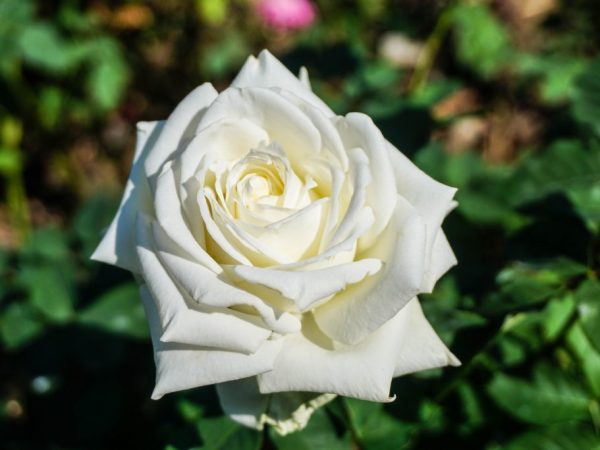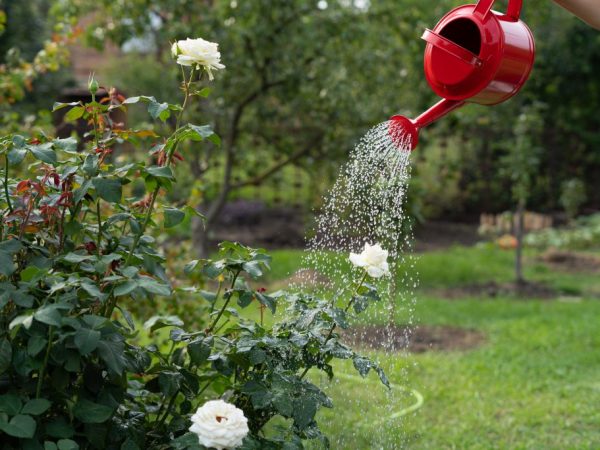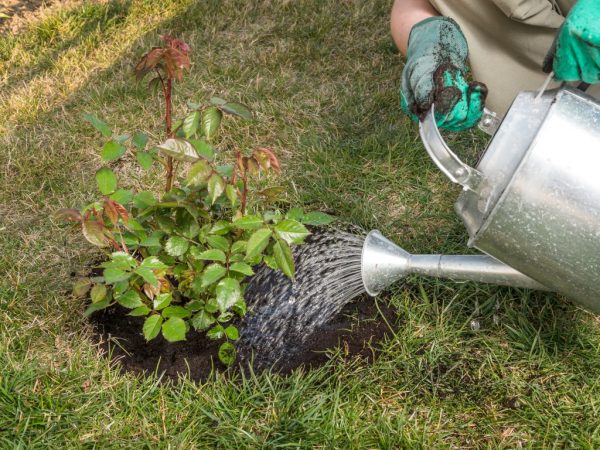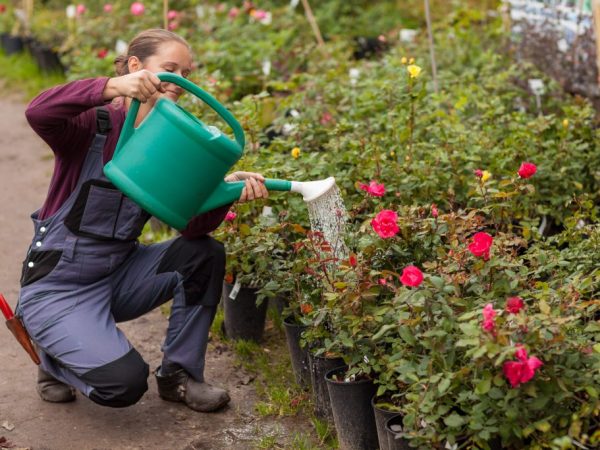Pre-winter feeding of roses - the subtleties of events
Top dressing of roses in autumn is a mandatory event that ensures abundant and beautiful flowering of the decorative culture in the next season. It also helps the plants to more comfortably endure the cold, because they differ in average winter hardiness.

Pre-winter feeding of roses - the subtleties of events
The purpose of autumn feeding
The need to feed roses in autumn is due to the active absorption of nutrients by the bush from the substrate throughout the growing season, as a result of which even the fertile soil is depleted.
Thanks to the application of fertilizers, it is possible to:
- Strengthen the root system sufficiently, so that wintering will be more successful.
- Increase immunity to diseases and pests. Often, in weakened specimens, due to a shortage of plastic substances from the effects of frost, the bark cracks, in the holes of which various bugs prefer to settle.
- Normalize soil fertility and nourish the rose with useful elements.
- It will be possible to increase winter hardiness by applying potash-phosphorus fertilizers. As a result, the plant receives the necessary "dose" of plastic substances responsible for the safety of the stems during temperature fluctuations. Ripening of shoots is additionally stimulated.
- To restore the strength that was expended by the rose in the process of autumn pruning.
Optimal timing
The choice of fertilizer that should be fed to the queen of the garden before the onset of winter directly depends on its variety and region of growth.
Species features
Climbing the rose is distinguished by a special sensitivity of the root system, therefore, in the autumn period it is necessary to strengthen the underground part of the plant.
- For the first procedure, a complex of boric acid, superphosphate and potassium sulphide is used.
- The second - must necessarily include phosphate-containing components.
Before fertilizing, the soil is carefully loosened, then covered with a layer of mulch.
The recommended time for agrotechnical works is August / September.
Regular. Prefers purchased preparations in the form of granules, which are distributed around the perimeter of the peri-stem circle and spilled with water. In autumn, the culture is especially in need of potassium magnesium and phosphorus.
Events are held at the end of August, duplicated in mid-September. In the future, the bush is subjected to major pruning.
Floribunda. There are a number of subtleties regarding the use of fertilizers. They are brought in once in early November, scattered over the surface of the soil near the stem. Preference is given to potash and phosphorus, chlorine-containing agents are prohibited. After the plant is covered for the winter. It is allowed to additionally use rotted manure for the second feeding.
Sadovaya. Needs double fertilization in autumn.
- For the first, a composition of calcium, phosphorus and a small amount of potassium should be prepared;
- The second is done with organic matter - manure or compost.
Park... Due to the breeding of the variety through complex selection, the plant must be carefully prepared for the cold season.
Feeding is allowed only after major pruning. Potash-phosphorus preparations are used as fertilizers.
Regional features
The timing of fertilizing, depending on the territory:
- In the South of Russia, the first falls on September 20-30, the second - on October 1-10.
- In the Urals and Siberia, the optimal periods are August 10-20 and September 1-10.
- In the middle lane, it is recommended to carry out work on August 20-30 and September 10-20.
Feeding methods

Autumn processing time depends on the variety
There are several ways of feeding the queen of the garden - root and foliar.
They can be used separately, but experienced gardeners combine both methods to achieve maximum effect.
Root
It involves the introduction of the drug directly under the root of the plant, from which nutrients are subsequently supplied to all organs of the flower.
Distinguish:
- Dry dressing. They are laid in undiluted form in small grooves along the perimeter of the near-stem space, or distributed over the soil surface and sprinkled lightly on it. Provided there is no rain in the fall and excessive dryness of the substrate, water abundantly.
- Liquid. In this case, mineral or organic fertilizers are diluted in the required amount of water, after which the resulting solution is poured under the trunk of the plant.
Foliar
The main advantage is the quick achievement of the result. In the course of work, a special spray bottle is used, with the help of which the green mass of the flower is sprayed with the necessary composition.
Manipulations should be carried out so that the drug falls on both the outer and inner parts of the sheet plates.
The method can be used simultaneously with the root method or as an independent one if the first one was carried out the day before. It is especially effective when it is necessary to combat harmful insects.
The spray solution is taken at a weak concentration. The procedure is carried out at a time when the sun is not in the active stage. The best option is evening and slightly cloudy weather without precipitation. Under such conditions, the drug will have time to be absorbed into the foliage before nightfall.
Organic fertilizers
It is recommended to apply autumn fertilizers for abundant flowering of roses in spring and comfortable wintering in several stages:
- In early September. It is carried out after the bush has faded. The goal is accelerated ripening of shoots and normalization of the substrate balance.
- Before the immediate onset of cold weather - in late October / early November. Designed to protect the root system.
To nourish the earth with organic matter means to provide the flower with the necessary elements for a long time, which is due to the ability of the means used to gradually penetrate into the soil.
The pluses also include the full range of nutrients contained in the composition.

Top dressing is carried out in several stages
| Fertilizer type | Benefit | Application time | Rules and peculiarities of application, dosage |
| Ash | Contains a large amount of potassium, phosphorus, calcium. Possesses insecticidal properties. Promotes the destruction of larvae and pathogens in the substrate. For the formation of large buds in the next season, it is recommended to use the ash remaining during the burning of potato tops. | With no restrictions | In dry form: distributed in the area of the periosteal circle at the rate of 1-2 tbsp per culture unit, then loosened to a shallow depth. In liquid form: an infusion is prepared from sifted ash and hot water in a ratio of 2 tablespoons to 3 liters. Withstand up to 3 days, then bring to the volume of a bucket by adding clean liquid. Poured under a bush (each has an average of 6 liters of funds). |
| Compost | Contains phosphorus, nitrogen, potassium compounds formed during the overheating of plant residues (weeds, leaves).It has properties due to which heat is retained, and therefore the likelihood of root freezing is minimized. | Late autumn after flowering | Lay out superficially in the area near the trunk at the rate of 1-2 kg per 1 sq. M. |
| Onion husk | Contains ascorbic acid, phytoncides, carotene, B vitamins. Accelerates the growth of the root system, enhances immunity. It can be used as a prophylactic agent against pests. | With no restrictions | In the form of an infusion: 500 g of husk is poured with liquid in a volume of 10 liters (temperature 40 degrees), cover the container with a lid, insist for a day in a dark room. Broth: the husk and water in similar proportions are boiled for several hours, after which they wait until they cool completely. Both products are used to spray the plant at intervals of 6 days. Allowed to be used as mulch. |
| Manure | It is considered a complex fertilizer containing phosphorus, nitrogen, potassium, iron, manganese, etc. | Preferably before flowering. Due to the high nitrogen content, it should be used carefully so as not to provoke the formation of new shoots that cannot withstand frost. The best option is the first feeding. | Dilute in a ratio of 1:10, insist for 7 days, additionally dilute with liquid at the rate of 1 part of the infusion to 3 parts of water. Watered at the root. |
| Chicken droppings | Properties are identical to manure | Before flowering | Dilute in a ratio of 1:20, insist for a week, before adding, dilute with liquid at the rate of 1 part of the infusion to 1 part of water. Watered at the root. |
| Eggshell | Contains about 27 useful trace elements. Among them are zinc, fluorine, molybdenum, phosphorus, manganese, iron. When naturally decomposed, it is easily absorbed into the soil. Helps normalize acidity by lowering Ph. Improves the drainage properties of the substrate. Perfectly fights slugs and snails. | End of August, additionally before the first forecasted frosts | The shell is crushed into powder, poured with liquid, kept for 4 days. The post is sprayed with leaves and watered at the root. It is better to collect the material from raw eggs, which are recommended to be rinsed in water before use. Can also be used dry by scattering over the soil surface. |
Mineral fertilizers

Top dressing has a positive effect on flower health
Mineral fertilizers are useful substances in high concentration, which are obtained in the course of a chemical reaction, converting raw materials of inorganic origin.
There are several types: simple, complex, micronutrient fertilizers.
| Fertilizer type | Name, features | Application time | Dosage, application rules |
| Nitrogen | Ammonium nitrate (increases soil acidity, nitrogen content 35%). | Mainly used in spring and summer. It is allowed to apply in late autumn before the flower shelter for the winter. In the latter case, nitrogen will not get to the roots, but will begin to be actively absorbed into the ground with melting snow. | Prepare a solution of 10 liters of water and 1 tbsp. saltpeter. Pour at least 5-7 liters of the product under the bush. |
| Urea (nitrogen at a concentration of 46%) | Spring | They are buried in the soil due to the fact that when interacting with oxygen, the active substance decomposes | |
| Potash | Potassium sulfate (does not contain chlorine, participates in strengthening the immune system, increases frost resistance). | During the budding period, in preparation for winter. Submitted until October inclusive | Prepare a solution of 10 liters of liquid and 1 tbsp. l. potassium sulfate, supplemented with a similar amount of superphosphate. Watered at the root. |
| Kalimagnesia (contains 30% potassium, 17% sulfur and 10% magnesium oxide, great for enriching sandy soils) | End of August, beginning of September | Under the root | |
| Phosphorus-potash | Simple / double superphosphate. Increases resistance to low temperatures, strengthens the root system, promotes the absorption of amino acids and sugars | End of August - early September | The granules are embedded in the soil or diluted with water at a dosage of 40-60 g per 1 sq. M. |
Top dressing in the autumn period must be taken extremely seriously, not only in order to provide the rose with a comfortable wintering. Correctly carried out activities also depend on how healthy the culture will be by the beginning of the next growing season.

